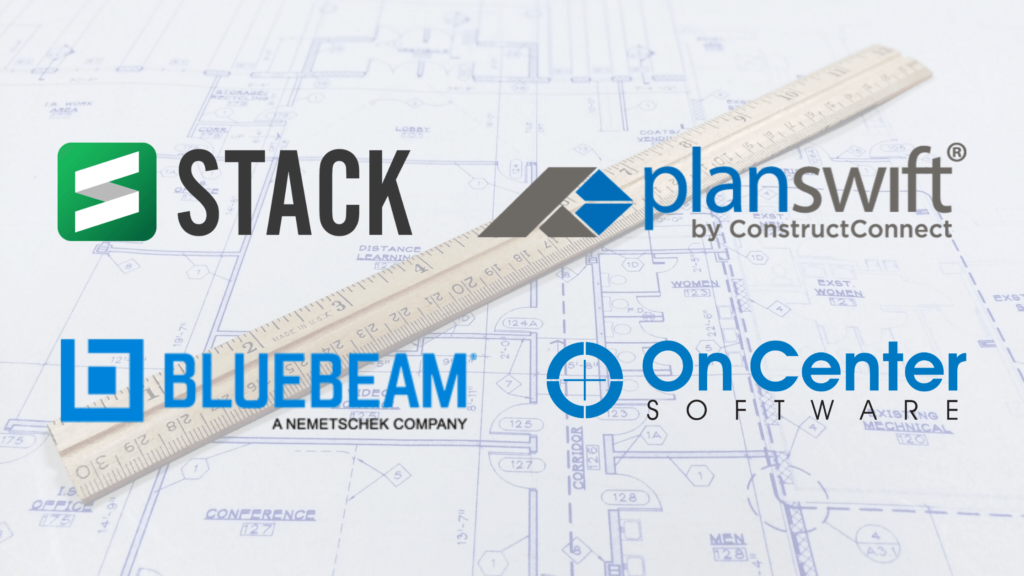Takeoff services help maintain accuracy by streamlining components of project planning. Common types include material takeoff, quantity takeoff, and cost estimation, each designed to improve efficiency and prevent costly mistakes. Whether using professional services or software, the right takeoff solution will significantly impact project success.
Quick look
- Takeoff services help contractors estimate materials, labor, and costs, preventing budget overruns and project delays.
- Accurate cost breakdowns improve budgeting, allowing construction teams to track material, labor, and equipment expenses while reducing waste.
- Takeoff software like PlanSwift, STACK, Bluebeam Revu, and On-Screen Takeoff automates calculations, reduces human error, and speeds up estimating for residential and commercial projects.
- Choosing between professional takeoff services and software depends on project complexity, budget, and the need for real-time updates.
What are takeoff services?

Construction takeoff services involve calculating the materials, quantities, and costs required for a project based on blueprints and specifications. These services help contractors and project managers estimate everything from lumber and concrete needed to labor costs and equipment expenses. By using professional estimators or specialized software, construction teams can generate accurate material lists, reduce waste, and prevent budget overruns. By using takeoff software, contractors ensure that projects stay on schedule and within budget.
Material takeoff
Material takeoff (MTO) is the process of determining the exact materials required for a construction project. Estimators analyze project blueprints and specifications to create a comprehensive list of materials needed at each stage of construction. This includes everything from lumber and steel to electrical wiring and concrete. A detailed material takeoff ensures contractors purchase the right supplies, reducing excess spending and preventing shortages.
Quantity takeoff
Quantity takeoff focuses on the precise measurement of materials and components required for a project. Unlike material takeoff, which lists the materials, quantity takeoff provides exact measurements such as cubic yards of concrete, square footage of drywall, or linear feet of piping.
Cost estimation
Cost estimation takes material and quantity takeoff a step further by calculating the total cost of materials, labor, and other expenses. Accurate estimates ensure projects stay within budget and prevent unexpected financial shortfalls. This process involves analyzing market prices, labor costs, equipment needs, and potential fluctuations in material prices.
Why takeoff services or software is important in construction
Takeoff services and software help construction professionals create accurate estimates, improve budgeting, and reduce material waste. Projects can suffer from delays, unexpected expenses, and inefficiencies without precise calculations. Here are the main benefits of using takeoff software:
Costs
Takeoff services provide clear cost breakdowns, helping contractors manage budgets effectively. By identifying material, labor, and equipment expenses upfront, companies can prevent overspending and improve financial forecasting.
Reduced waste
Accurate takeoff calculations ensure materials are ordered in precise quantities, reducing surplus and minimizing job site waste. This leads to lower disposal costs and a more sustainable construction process.
Data transfer
Digital takeoff software integrates with other project management tools, allowing seamless data transfer between estimating, procurement, and scheduling teams. This reduces errors and improves collaboration across departments.
Productivity
Automating takeoff calculations speeds up the estimating process, giving contractors more time to focus on other critical aspects of project management. Manual takeoff can be time-consuming, but software solutions streamline the process.
Accuracy
Precision is crucial in construction, and takeoff services help eliminate human error. With reliable data, contractors can avoid miscalculations that could lead to budget overruns or supply shortages.
Time savings
By automating material and cost estimates, takeoff software reduces the time spent on manual calculations. This speeds up the bidding process and allows teams to start projects faster.
Labor planning
Accurate takeoff data helps project managers allocate labor efficiently. It ensures that the right number of workers are assigned to each construction phase to prevent understaffing and unnecessary labor costs.
Bid competitiveness
A well-prepared takeoff allows contractors to create more competitive bids by presenting precise cost estimates. This increases the chances of winning contracts without underpricing or overcommitting resources.
Professional services vs software: Which should you choose?
Deciding between professional takeoff services and software depends on project size, budget, and in-house expertise. Professional services provide expert analysis, eliminating the need for contractors to perform takeoff calculations themselves. This benefits companies that lack the time or resources to handle estimating internally. However, outsourcing can be costly, and turnaround times depend on the service provider’s availability.
Takeoff software, on the other hand, offers automation and real-time data updates. It’s an excellent option for businesses that want to maintain control over their estimates while improving efficiency. While software requires an initial investment and training, it pays off by streamlining estimating processes and reducing human error. The best choice depends on whether a company values expert analysis or prefers the flexibility of in-house automation.
How to find the right takeoff software for your company
Finding the right takeoff software for your company starts with evaluating your project needs and workflow. Here are our top tips to consider when choosing a takeoff software:
- Look for software that integrates with existing project management tools
- Prioritize ease of use and a user-friendly interface
- Choose a platform that provides real-time cost updates based on market prices
- Consider cloud-based solutions for better collaboration and accessibility
- Evaluate customer support and training options before committing
Best personal takeoff software to consider

STACK
STACK is a cloud-based takeoff and estimating software designed to help contractors, estimators, and project managers work more efficiently. Since it operates entirely online, teams can access project data from anywhere, making collaboration seamless. Real-time updates ensure that everyone works with the most accurate and current information, reducing errors caused by outdated documents.
STACK is a versatile tool that supports takeoff for various construction trades, from drywall and roofing to plumbing and electrical. The software also integrates with other project management platforms, streamlining workflows and reducing the need for manual data entry. Its pre-built material database allows users to generate precise estimates quickly, improving accuracy and cost control. For companies looking for a scalable and user-friendly solution, STACK Construction Technologies offers free and paid plans to fit different business needs.
PlanSwift
PlanSwift is a user-friendly takeoff software built for speed and accuracy, making it a go-to choice for contractors and estimators who need quick results. Its drag-and-drop functionality allows users to measure materials and costs directly from digital blueprints, eliminating the need for manual calculations. The software supports a variety of construction trades, from framing and concrete to electrical and HVAC, making it a flexible solution for different projects.
PlanSwift’s integration with Excel and other estimating programs allows for smooth data transfer, reducing redundant work. Users can create custom assemblies to streamline future estimates, saving time on repetitive calculations. The program also offers plugins and add-ons that cater to specific industry needs, enhancing its functionality. With its straightforward interface and powerful features, PlanSwift is an excellent choice for contractors looking for an efficient and reliable estimating tool.
Bluebeam Revu
Bluebeam Revu is a powerful software solution that combines takeoff capabilities with advanced digital plan markup tools. Unlike traditional estimating software, Bluebeam allows contractors to annotate blueprints, collaborate in real-time, and track project changes throughout the construction process. Its measurement tools help users calculate material quantities directly from PDFs, ensuring precision in estimating. Bluebeam also integrates with cloud storage services, allowing easy file sharing among team members.
The software is widely used in construction, architecture, and engineering, making it a valuable asset for companies needing a comprehensive digital workflow solution. With features like batch processing and customizable toolsets, users can streamline repetitive tasks and improve efficiency. Whether working on small residential projects or large commercial builds, Bluebeam Revu offers a robust set of tools for accurate takeoffs and project documentation.
On-Screen Takeoff
On-Screen Takeoff (OST) is a widely used software solution that helps contractors perform detailed quantity takeoffs and cost analysis with precision. Its user-friendly interface allows estimators to measure materials directly from digital plans, reducing the risk of miscalculations. The software supports a variety of file formats, making it easy to import blueprints from different sources. OST also includes advanced tools for organizing and categorizing takeoff data, ensuring that estimates remain accurate and well-structured.
The ability to overlay revisions helps users track changes efficiently, minimizing costly mistakes. Additionally, the software integrates with many estimating and project management systems, enhancing workflow efficiency. On-Screen Takeoff is a great choice for contractors who need a reliable and flexible solution for estimating materials, labor, and overall project costs.
Bottom line
Efficient takeoff services save time, reduce costs, and improve construction project planning. Whether outsourcing to professionals or investing in software, accurate estimates prevent unnecessary expenses and delays.
Stay updated on industry insights and learn more about how construction software can benefit your business—subscribe to our newsletter and follow us on social media.


